Hyundai Santa Fe: Cylinder Block / Piston and Connecting Rod. Repair procedures
| •
|
Be careful not to damage the parts located under the vehicle
(floor under cover, fuel filter, fuel tank and canister) when
raising the vehicle using the lift.
(Refer to General Information - "Lift and Support Points")
|
|
| •
|
Use fender covers to avoid damaging painted surfaces.
|
| •
|
To avoid damage, unplug the wiring connectors carefully while
holding the connector portion.
|
|
| •
|
Mark all wiring and hoses to avoid misconnection.
|
| •
|
Turn the crankshaft pulley so that the No.1 piston is at top
dead center.
|
| •
|
Engine removal is required for this procedure.
|
|
|
1. |
Remove the engine and transaxle assembly.
(Refer to Engine and Transaxle Assembly - "Engine and Transaxle Assembly")
|
|
2. |
Remove the harness clamp from the wiring connector around the engine
and transaxle and remove the connector bracket.
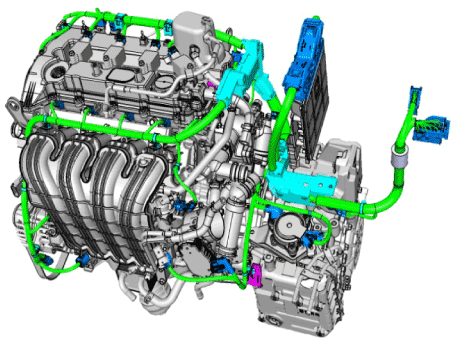
|
|
3. |
Remove the automatic transaxle .
(Refer to Automatic Transaxle System - "Automatic Transaxle")
|
|
4. |
Remove the drive plate.
(Refer to Cylinder Block - "Drive Plate")
|
|
5. |
Remove the rear oil seal.
(Refer to Cylinder Block - "Rear Oil Seal")
|
|
6. |
Install the engine assembly to engine stand for disassembly.
|
|
7. |
Remove the oil pan.
(Refer to Lubrication System - "Oil Pan")
|
|
8. |
Remove the timing chain.
(Refer to Timing System - "Timing Chain")
|
|
9. |
Remove the intake manifold.
(Refer to Intake and Exhaust System - "Intake Manifold")
|
|
10. |
Remove the exhaust manifold.
(Refer to Intake and Exhaust System - "Exhaust Manifold")
|
|
11. |
Remove the cylinder head.
(Refer to Cylinder Head Assembly - "Cylinder Head")
|
|
12. |
Remove the water jacket insert.
(Refer to Cylinder Block - "Water Jacket Insert")
|
|
13. |
Remove the oil cooler & filter.
(Refer to Lubrication System - "Oil Cooler & Filter")
|
|
14. |
Remove the alternator.
(Refer to Engine Electrical System - "Alternator")
|
|
15. |
Remove the A/C compressor.
(Refer to Heateng, Ventilation, Air conditioning - "Compressor")
|
|
16. |
Remove the tensioner assembly integrated bracket (A).
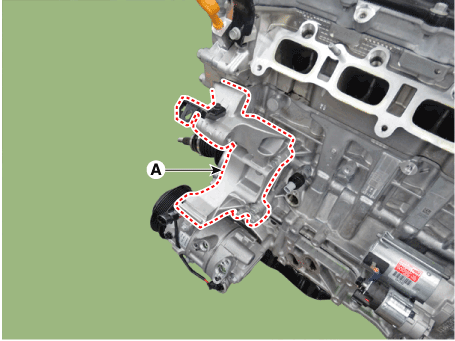
|
|
17. |
Remove the oil pump.
(Refer to Lubrication System - "Oil Pump")
|
|
18. |
Remove the balance shaft module.
(Refer to Lubrication system - "Balance Shaft Module")
|
|
19. |
Remove the piston and connecting rod assembly.
|
(1) |
Remove all the carbon from the top of the cylinder.
|
|
(2) |
Remove the connecting rod bearing caps (A).
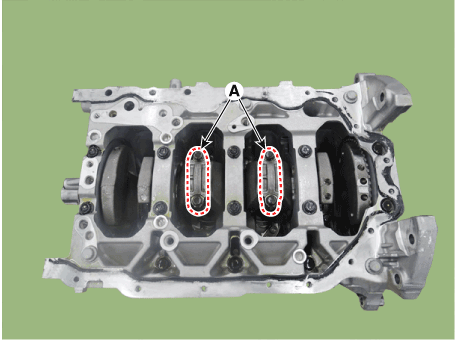
|
• |
Mark the connecting rod, and caps to be able
to reassemble in the original position and direction.
|
|
|
|
(3) |
Push the piston and connecting rod assembly (A) with upper bearing
through the top of the cylinder block.
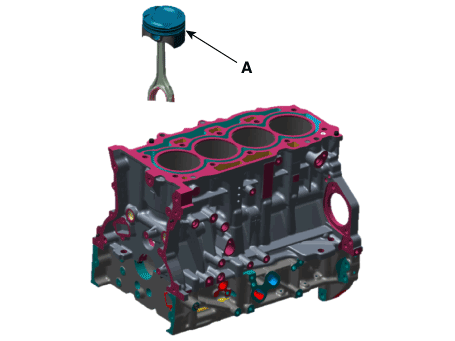
|
• |
Keep the connecting rod ands cap with their
bearings assembled together.
|
|
• |
Arrange the piston and connecting rod assemblies
in the correct order.
|
|
|
|
|
20. |
Check fit between piston and piston pin.
Try to move the piston back and forth on the piston pin. If any movement
is felt, replace the piston and piston pin as a set.
|
|
21. |
Disassemble the piston rings.
|
(1) |
Using a piston ring expender, remove the 2 piston rings (A).
|
|
(2) |
Remove the oil ring (B) by hand.
|
|
|
22. |
Disassemble the connecting rod from the piston.
|
(1) |
Remove the snap ring (C) from the piston.
|
|
(2) |
Using a press, remove the piston pin (D) from the piston.
|
|
(3) |
Disassemble the piston (E) and connecting rod (F).
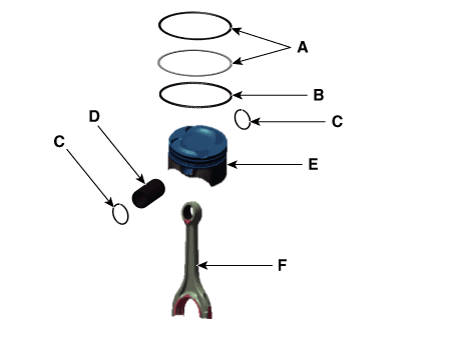
|
|
Connecting Rod
|
1. |
Check the connecting rod end play.
Using a feeler gauge, measure the end play while moving the connecting
rod back and forth.
|
End play :
Standard : 0.10- 0.25 mm (0.0039 - 0.0098 in.)
Limit : 0.35 mm (0.0138 in.)
|
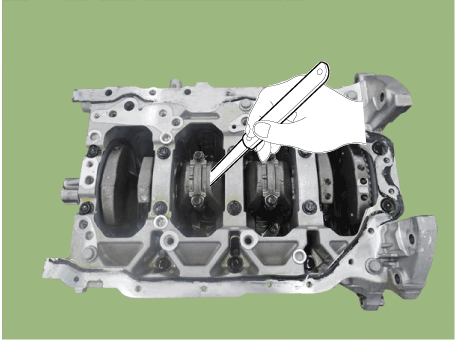
| •
|
If out-of-tolerance, install a new connecting rod.
|
| •
|
If still out-of-tolerance, replace the crankshaft.
|
|
|
2. |
Check the connecting road bearing oil clearance.
|
(1) |
Check the matchmarks on the connecting rod and cap are aligned
to ensure correct reassembly.
|
|
(2) |
Remove 2 connecting rod cap bolts.
|
|
(3) |
Remove the connecting rod cap and bearing half.
|
|
(4) |
Clean the crank pin and bearing.
|
|
(5) |
Place plastigage across the crank pin.
|
|
(6) |
Reinstall the bearing half and cap, and torque the bolts.
|
Tightening torque
17.7 - 21.6 N.m (1.8 - 2.2 kgf.m, 13.0 - 15.9 lb-ft)
+ 88 - 92°
|
|
• |
Do not turn the crankshaft.
|
|
|
|
(7) |
Remove 2 bolts, connecting rod cap and bearing half.
|
|
(8) |
Measure the plastigage at its widest point.
|
Standard oil clearance :
0.032 - 0.050 mm (0.0013 - 0.0020 in.)
|
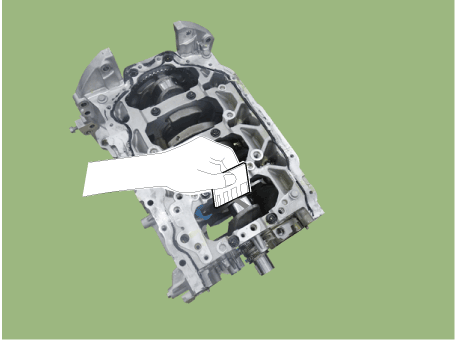
|
|
(9) |
If the plastigage measures too wide or too narrow, remove the
upper half of the bearing, install a new, complete bearing with
the same color mark (select the color as shown in the next column),
and recheck the clearance.
|
• |
Do not file, shim, or scrape the bearings or
the caps to adjust clearance.
|
|
|
|
(10) |
If the plastigage shows the clearance is still incorrect, try
the next larger or smaller bearing (the color listed above or
below that one), and check clearance again.
|
• |
If the proper clearance cannot be obtained by
using the appropriate larger or smaller bearings,
replace the crankshaft and start over.
|
|
|
• |
If the marks are indecipherable because of an
accumulation of dirt and dust, do not scrub
them with a wire brush or scraper. Clean them
only with solvent or detergent.
|
|
Connecting Rod Identification Mark
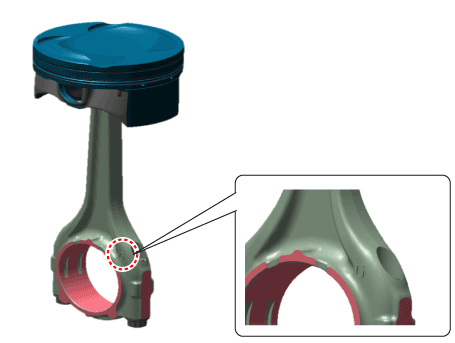
Connecting Rod Specifications
Class
|
Mark
|
Inside Diameter
|
0
|
A
|
51.000 - 51.006 mm
(2.00787 - 2.00811 in.)
|
1
|
B
|
51.006 - 51.012 mm
(2.00811 - 2.00834 in.)
|
2
|
C
|
51.012 - 51.018 mm
(2.00834 - 2.00858 in.)
|
Crankshaft Pin Outside Diameter Identification Mark
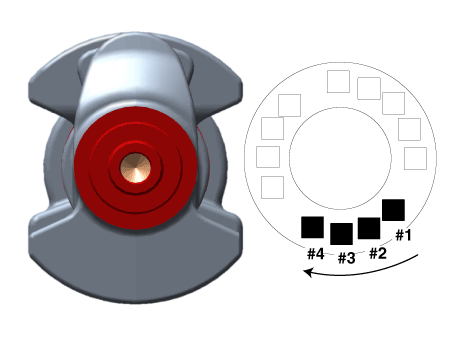
Identification Of Crankshaft Pin Outside Diameter
Class
|
Mark
|
Crankshaft pin journal outer diameter
|
A
|
1
|
47.966 - 47.972 mm
(1.8884 - 1.8887 in.)
|
B
|
2
|
47.960 - 47.966 mm
(1.8882 - 1.8884 in.)
|
C
|
3
|
47.954 - 47.960 mm
(1.8879 - 1.8882 in.)
|
Connecting Rod Bearing Identification Mark
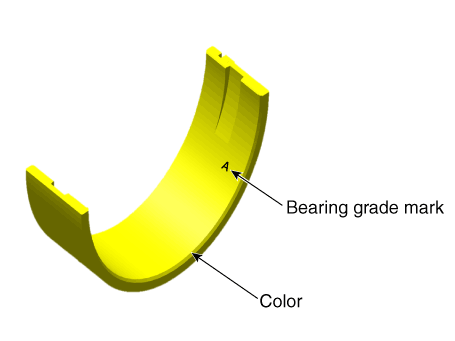
Discrimination of Connecting Rod Bearing
Class
|
Color
|
Connecting rod bearing thickness
|
A
|
LIGHT BLUE
|
1.507 - 1.510 mm
(0.0593 - 0.0594 in.)
|
B
|
BLACK
|
1.504 - 1.507 mm
(0.0592 - 0.0593 in.)
|
C
|
WHITE
|
1.501 - 1.504 mm
(0.0591 - 0.0592 in.)
|
D
|
LIGHT GREEN
|
1.498 - 1.501 mm
(0.0590 - 0.0591 in.)
|
E
|
PINK
|
1.495 - 1.498 mm
(0.0589 - 0.0590 in.)
|
|
|
(11) |
Use the bearing selection table below to select a suitable connecting
rod bearing.
Connecting Rod Bearing Selection Table
SHAFT (CLASS. MARK)
|
Bore (CLASS. MARK)
|
Bearing Grade For Installing
|
I (1)
|
a (A)
|
E (PINK)
|
b (B)
|
D (LIGHT GREEN)
|
c (C)
|
C (WHITE)
|
II (2)
|
a (A)
|
D (LIGHT GREEN)
|
b (B)
|
C (WHITE)
|
c (C)
|
B (BLACK)
|
III (3)
|
a (A)
|
C (WHITE)
|
b (B)
|
B (BLACK)
|
c (C)
|
A (LIGHT BLUE)
|
|
|
|
3. |
Inspect the connecting rods.
|
(1) |
When reinstalling, make sure that cylinder numbers put on the
connecting rod and cap at disassembly match. When a new connecting
rod is installed, make sure that the notches for holding the
bearing in place are on the same side.
|
|
(2) |
Replace the connecting rod if it is damaged on the thrust faces
at either end. Also if step wear or a severely rough surface
of the inside diameter of the small end is apparent, the rod
must be replaced as well.
|
|
(3) |
Using a connecting rod aligning tool, check the rod for
|
Allowable bend of connecting rod :
0.05mm (0.0020 in.) or less for 100mm (3.94 in.)
Allowable twist of connecting rod :
0.10mm (0.0039 in.) or less for 100mm (3.94 in.)
|
|
|
Piston
|
1. |
Clean piston
|
(1) |
Using a gasket scraper, remove the carbon from the piston top.
|
|
(2) |
Using a groove cleaning tool or broken ring, clean the piston
ring grooves.
|
|
(3) |
Using solvent and a brush, thoroughly clean the piston.
|
|
|
2. |
Check the piston-to-cylinder clearance by calculating the difference
between the cylinder bore inner diameter and the piston outer diameter.
|
Piston-to-cylinder clearance :
0.04 - 0.06 mm (0.0016 - 0.0024 in.)
|
|
(1) |
Using a cylinder bore gauge, measure the cylinder bore diameter
at position in the thrust and axial direction.
|
Cylinder bore diameter :
88.50 - 88.53 mm (3.4842 - 3.4854 in.)
|
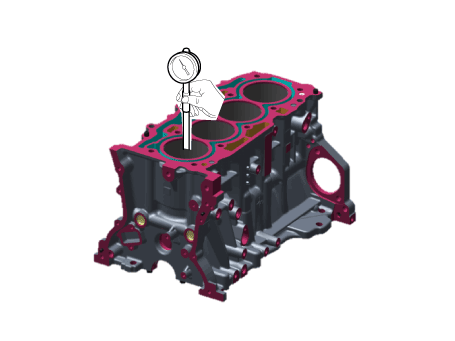
|
|
(2) |
Measure the piston outside diameter at 13.0 mm (0.5118 in.)
from top land of the piston.
|
Piston outside diameter :
88.45 - 88.48 mm (3.4823 - 3.4835 in.)
|
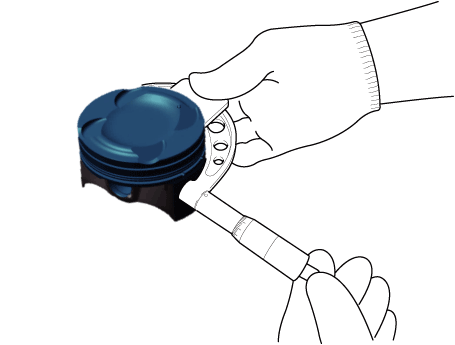
|
|
|
3. |
Select the piston matching with cylinder bore class.
|
Piston-to-cylinder clearance :
0.04 - 0.06 mm (0.0016 - 0.0024 in.)
|
|
(1) |
Check the cylinder bore size mark on the side of the cylinder
block.
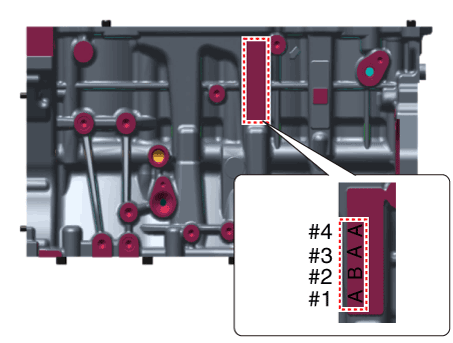
Letters have been stamped on the block as a mark for the size
of each of the 5 main journal bores.
Use them, and the numbers or bar stamped on the crank (marks
for main journal size), to choose the correct bearings.
Discrimination of Cylinder Bore Size
Class
|
Mark
|
Cylinder bore inner diameter
|
a
|
A
|
88.50 - 88.51 mm
(3.4842 - 3.4846 in.)
|
b
|
B
|
88.51 - 88.52 mm
(3.4846 - 3.4850 in.)
|
c
|
C
|
88.52 - 88.53 mm
(3.4850 - 3.4854 in.)
|
|
|
(2) |
Check the piston outer diameter size mark (A) on the piston
top face.
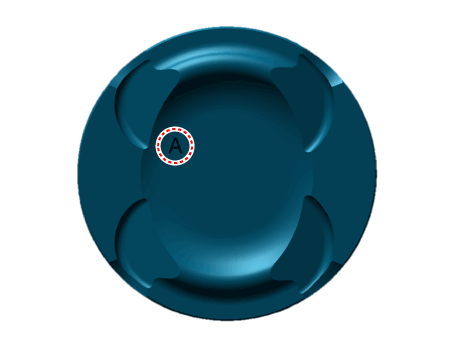
Discrimination of Piston Outer Diameter
Mark
|
Piston outer diameter
|
A
|
88.45 - 88.46 mm
(3.4823 - 3.4827 in.)
|
B
|
88.46 - 88.47 mm
(3.4827 - 3.4831 in.)
|
C
|
88.47 - 88.48 mm
(3.4831 - 3.4835 in.)
|
|
|
Piston Rings
|
1. |
Inspect the piston ring side clearance.
Using a feeler gauge, measure the clearance between new piston ring
and the wall of ring groove.
|
Piston ring groove width dimension of piston
No.1 ring :
1.258 - 1.268 mm (0.0495 - 0.0499 in.) (Befor ANODIZING)
1.235 - 1.250 mm (0.0486 - 0.0492 in.) (After ANODIZING)
No.2 ring : 1.230 - 1.250 mm (0.0484 - 0.0492 in.)
Oil ring : 2.010 - 2.025 mm (0.0791 - 0.0797 in.)
Piston ring width dimension
No.1 ring : 1.17 - 1.19 mm (0.0461 - 0.0469 in.)
No.2 ring : 1.17 - 1.19 mm (0.0461 - 0.0469 in.)
Oil ring : 1.91 - 1.97 mm (0.0752 - 0.0776 in.)
|
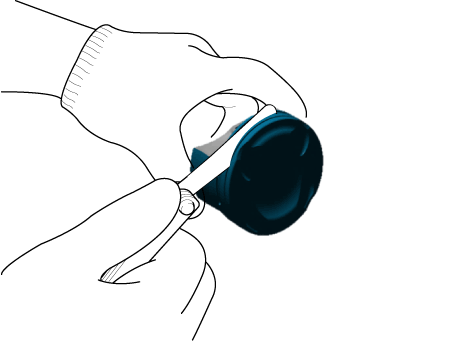
|
|
2. |
Inspect the piston ring end gap.
To measure the piston ring end gap, insert a piston ring into the cylinder
bore. Position the ring at right angles to the cylinder wall by gently
pressing it down with a piston. Measure the gap with a feeler gauge.
If the gap exceeds the specifications, replace the piston rings. If
the gap is too large, recheck the cylinder bore inner diameter.
|
Piston ring end gap
[Standard]
No.1 ring : 0.14 - 0.19 mm (0.0055 - 0.0075 in.)
No.2 ring : 0.30 - 0.40 mm (0.0118 - 0.0157 in.)
Oil ring : 0.10 - 0.40 mm (0.0039 - 0.0157 in.)
|
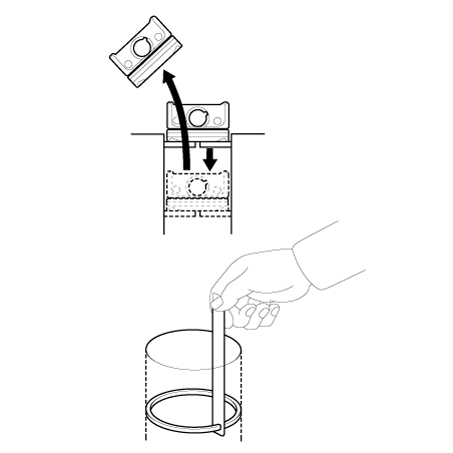
|
Piston Pin
|
1. |
Measure the diameter of the piston pin.
|
Piston pin diameter :
19.997 - 20.000mm (0.7873 - 0.7874 in.)
|
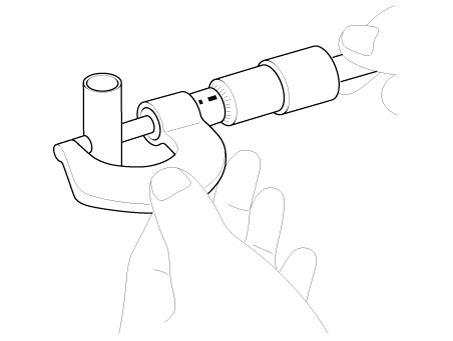
|
|
2. |
Measure the piston pin-to-piston clearance.
|
Piston pin-to-piston clearance :
0.003 - 0.010 mm (0.00012 - 0.00039 in.)
|
|
|
3. |
Check the difference between the piston pin diameter and the connecting
rod bushing oil clearance.
|
Piston pin-to-connecting rod interference :
0.005 - 0.014 mm (0.00020 - 0.00055 in.)
|
|
| •
|
Thoroughly clean all parts to assembled.
|
| •
|
Before installing the parts, apply fresh engine oil to all sliding
and rotating surfaces.
|
| •
|
Always use new gaskets, O-ring and oil seals.
|
|
|
1. |
Assemble the piston and the connecting rod.
|
(1) |
Install the snap ring (A) in one side of the piston pin hole.
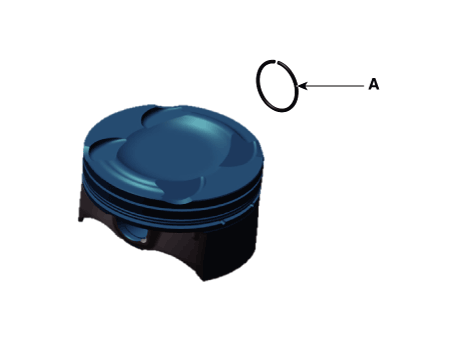
|
|
(2) |
Align the piston front mark (A) and the connecting rod front
mark (B).
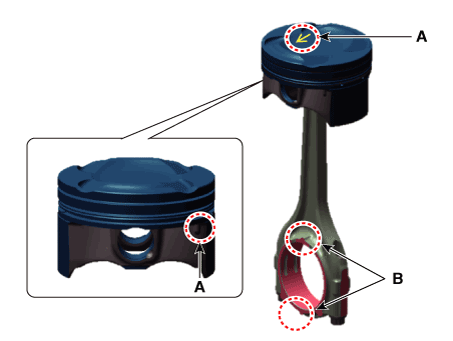
|
|
(3) |
Insert the piston pin (A) into the piston pin hole and the small
end bore of connecting rod.
|
|
(4) |
Install the snap ring (B) in the other side after inserting
the piston pin.
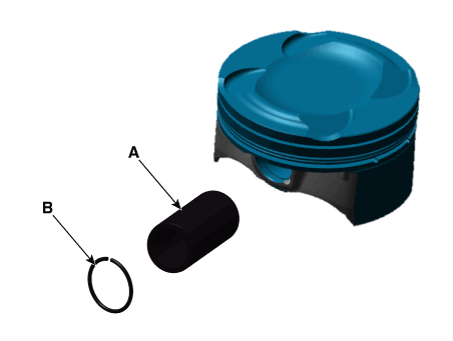
|
• |
Before inserting the piston pin, apply sufficient
engine oil on the piston’s outer surface, piston
hole’s inner surface and connecting rod’s small-end
bore.
|
|
• |
When inserting, use caution not to damage or
scratch the connecting rods’ small-end hole,
piston’s pin hole and piston pin.
|
|
• |
Install the snap ring surely so that the snap
ring contacts the overall groove of the piston’s
pin hole.
|
|
• |
Assemble so that the cut surface of the snap
ring is located within the upper 45° range.
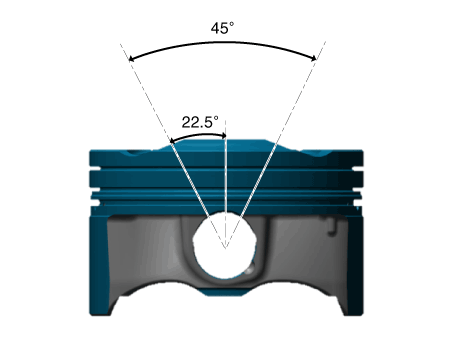
|
|
|
|
|
2. |
Install the piston rings.
|
(1) |
Install the oil ring expander and two side rails by hand.
|
|
(2) |
Using a piston ring expander, install the 2 compression rings
with the maker mark facing upward.
|
|
(3) |
Position the piston rings so that the ring ends are as shown.
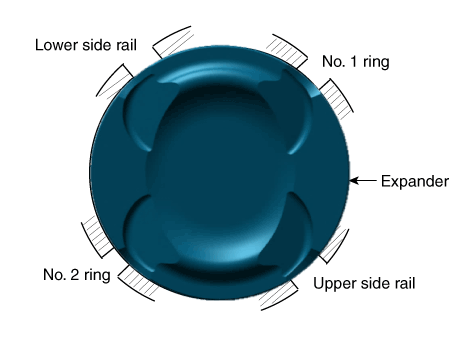
|
|
|
3. |
Install the connecting rod bearings.
|
(1) |
Align the bearing (B) claw with the groove of the connecting
rod or bearing cap (A).
|
|
(2) |
Install the bearings (B) in the connecting rod and bearing cap
(A).
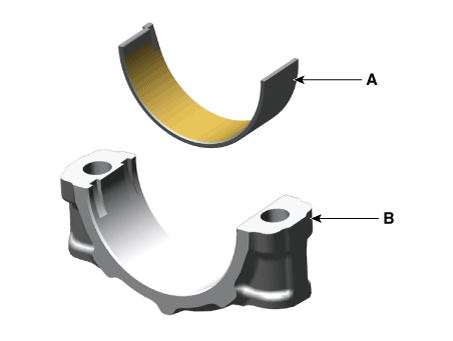
|
|
|
4. |
Install the piston and connecting rod assembly.
|
• |
Before installing the piston, apply a coat of engine
oil to the piston ring grooves and cylinder bores.
|
|
• |
The piston front mark (A) and the connecting rod front
mark (B) must face the timing chain side of the engine.

|
|
|
(1) |
Install the ring compressor, check that the rings are securely
in place, then position the piston in the cylinder, and tap
it in using the wooden handle of a hammer.
|
|
(2) |
Stop after the ring compressor pops free, and check the connecting
rod-to-crank journal alignment before pushing the piston into
place.
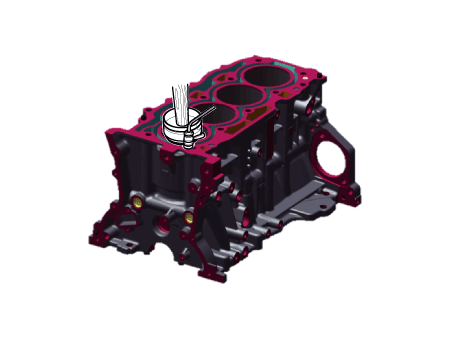
|
• |
Maintain downward force on the ring compressor
to prevent the rings from expanding before entering
the cylinder bore.
|
|
|
|
(3) |
Install the connecting rod caps (A) with bearings, and tighten
the bolts.
|
Tightening torque
17.7 - 21.6 N.m (1.8 - 2.2 kgf.m, 13.0 - 15.9 lb-ft)
+ 88 - 92°
|

|
• |
Always use new connecting rod cap bolts.
|
|
|
|
|
5. |
Assemble the other parts in the reverse order of disassembly.
|
Components
1. Piston ring
2. Snap ring
3. Piston
4. Connecting rod
5. Connecting
rod upper bearing
6...
Components
1. Crankshaft
upper bearing
2. Thrust bearing
3. Crankshaft
4. Crankshaft lower bearing
5. Crankshaft
sprocket
6...
Other information:
..
Forward and backward (2nd row seat)
To move the seat forward or backward:
1. Pull the seat slide adjustment lever up and hold it.
2. Slide the seat to the position you desire.
3. Release the lever and make sure the seat is locked in place.
Adjust the seat before driving, and make sure the seat is locked securely by
trying to move forward and backward without using the lever...
Categories
Engine oil pressure warning light
.png)
This warning light illuminates:
When the engine oil pressure is low.
If the engine oil pressure is low:
1. Drive carefully to the nearest safe location and stop your vehicle.
2. Turn the engine off and check the engine oil level (For more details, refer
to “Engine Oil” section in chapter 9). If the level is low, add oil as required.
read more
 Piston and Connecting Rod. Components and components location
Piston and Connecting Rod. Components and components location Crankshaft. Components and components location
Crankshaft. Components and components location.png)


























